吴裕雄--天生自然python Google深度学习框架:经典卷积神经网络模型



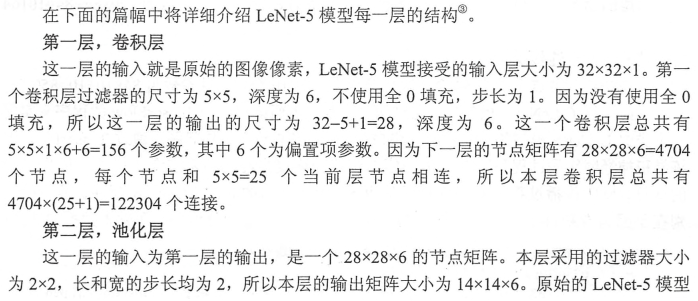
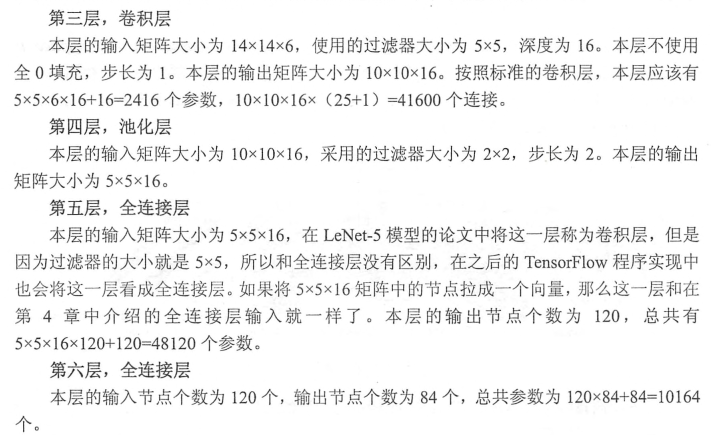
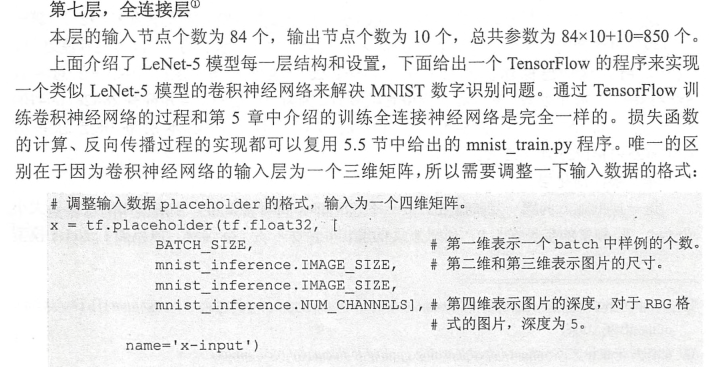

import tensorflow as tf INPUT_NODE = 784
OUTPUT_NODE = 10 IMAGE_SIZE = 28
NUM_CHANNELS = 1
NUM_LABELS = 10 CONV1_DEEP = 32
CONV1_SIZE = 5 CONV2_DEEP = 64
CONV2_SIZE = 5 FC_SIZE = 512 def inference(input_tensor, train, regularizer):
with tf.variable_scope('layer1-conv1'):
conv1_weights = tf.get_variable(
"weight", [CONV1_SIZE, CONV1_SIZE, NUM_CHANNELS, CONV1_DEEP],
initializer=tf.truncated_normal_initializer(stddev=0.1))
conv1_biases = tf.get_variable("bias", [CONV1_DEEP], initializer=tf.constant_initializer(0.0))
conv1 = tf.nn.conv2d(input_tensor, conv1_weights, strides=[1, 1, 1, 1], padding='SAME')
relu1 = tf.nn.relu(tf.nn.bias_add(conv1, conv1_biases)) with tf.name_scope("layer2-pool1"):
pool1 = tf.nn.max_pool(relu1, ksize = [1,2,2,1],strides=[1,2,2,1],padding="SAME") with tf.variable_scope("layer3-conv2"):
conv2_weights = tf.get_variable(
"weight", [CONV2_SIZE, CONV2_SIZE, CONV1_DEEP, CONV2_DEEP],
initializer=tf.truncated_normal_initializer(stddev=0.1))
conv2_biases = tf.get_variable("bias", [CONV2_DEEP], initializer=tf.constant_initializer(0.0))
conv2 = tf.nn.conv2d(pool1, conv2_weights, strides=[1, 1, 1, 1], padding='SAME')
relu2 = tf.nn.relu(tf.nn.bias_add(conv2, conv2_biases)) with tf.name_scope("layer4-pool2"):
pool2 = tf.nn.max_pool(relu2, ksize=[1, 2, 2, 1], strides=[1, 2, 2, 1], padding='SAME')
pool_shape = pool2.get_shape().as_list()
nodes = pool_shape[1] * pool_shape[2] * pool_shape[3]
reshaped = tf.reshape(pool2, [pool_shape[0], nodes]) with tf.variable_scope('layer5-fc1'):
fc1_weights = tf.get_variable("weight", [nodes, FC_SIZE],
initializer=tf.truncated_normal_initializer(stddev=0.1))
if regularizer != None: tf.add_to_collection('losses', regularizer(fc1_weights))
fc1_biases = tf.get_variable("bias", [FC_SIZE], initializer=tf.constant_initializer(0.1)) fc1 = tf.nn.relu(tf.matmul(reshaped, fc1_weights) + fc1_biases)
if train: fc1 = tf.nn.dropout(fc1, 0.5) with tf.variable_scope('layer6-fc2'):
fc2_weights = tf.get_variable("weight", [FC_SIZE, NUM_LABELS],
initializer=tf.truncated_normal_initializer(stddev=0.1))
if regularizer != None: tf.add_to_collection('losses', regularizer(fc2_weights))
fc2_biases = tf.get_variable("bias", [NUM_LABELS], initializer=tf.constant_initializer(0.1))
logit = tf.matmul(fc1, fc2_weights) + fc2_biases return logit
import tensorflow as tf
from tensorflow.examples.tutorials.mnist import input_data
import LeNet5_infernece
import os
import numpy as np BATCH_SIZE = 100
LEARNING_RATE_BASE = 0.01
LEARNING_RATE_DECAY = 0.99
REGULARIZATION_RATE = 0.0001
TRAINING_STEPS = 6000
MOVING_AVERAGE_DECAY = 0.99 def train(mnist):
# 定义输出为4维矩阵的placeholder
x = tf.placeholder(tf.float32, [
BATCH_SIZE,
LeNet5_infernece.IMAGE_SIZE,
LeNet5_infernece.IMAGE_SIZE,
LeNet5_infernece.NUM_CHANNELS],
name='x-input')
y_ = tf.placeholder(tf.float32, [None, LeNet5_infernece.OUTPUT_NODE], name='y-input') regularizer = tf.contrib.layers.l2_regularizer(REGULARIZATION_RATE)
y = LeNet5_infernece.inference(x,False,regularizer)
global_step = tf.Variable(0, trainable=False) # 定义损失函数、学习率、滑动平均操作以及训练过程。
variable_averages = tf.train.ExponentialMovingAverage(MOVING_AVERAGE_DECAY, global_step)
variables_averages_op = variable_averages.apply(tf.trainable_variables())
cross_entropy = tf.nn.sparse_softmax_cross_entropy_with_logits(logits=y, labels=tf.argmax(y_, 1))
cross_entropy_mean = tf.reduce_mean(cross_entropy)
loss = cross_entropy_mean + tf.add_n(tf.get_collection('losses'))
learning_rate = tf.train.exponential_decay(
LEARNING_RATE_BASE,
global_step,
mnist.train.num_examples / BATCH_SIZE, LEARNING_RATE_DECAY,
staircase=True) train_step = tf.train.GradientDescentOptimizer(learning_rate).minimize(loss, global_step=global_step)
with tf.control_dependencies([train_step, variables_averages_op]):
train_op = tf.no_op(name='train') # 初始化TensorFlow持久化类。
saver = tf.train.Saver()
with tf.Session() as sess:
tf.global_variables_initializer().run()
for i in range(TRAINING_STEPS):
xs, ys = mnist.train.next_batch(BATCH_SIZE) reshaped_xs = np.reshape(xs, (
BATCH_SIZE,
LeNet5_infernece.IMAGE_SIZE,
LeNet5_infernece.IMAGE_SIZE,
LeNet5_infernece.NUM_CHANNELS))
_, loss_value, step = sess.run([train_op, loss, global_step], feed_dict={x: reshaped_xs, y_: ys}) if i % 1000 == 0:
print("After %d training step(s), loss on training batch is %g." % (step, loss_value)) def main(argv=None):
mnist = input_data.read_data_sets("../../../datasets/MNIST_data", one_hot=True)
train(mnist) if __name__ == '__main__':
main()
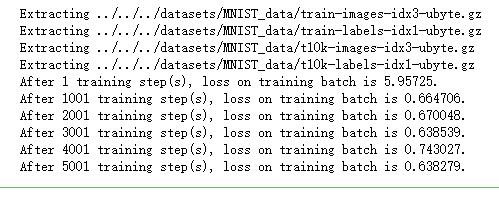
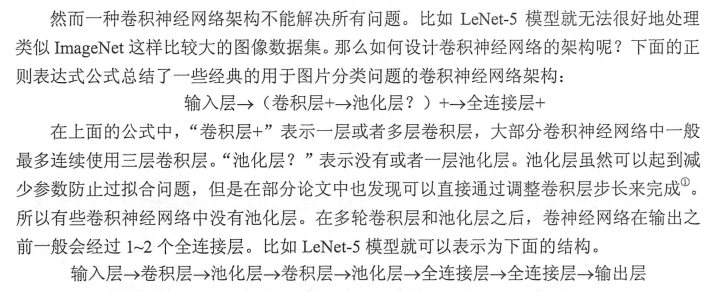

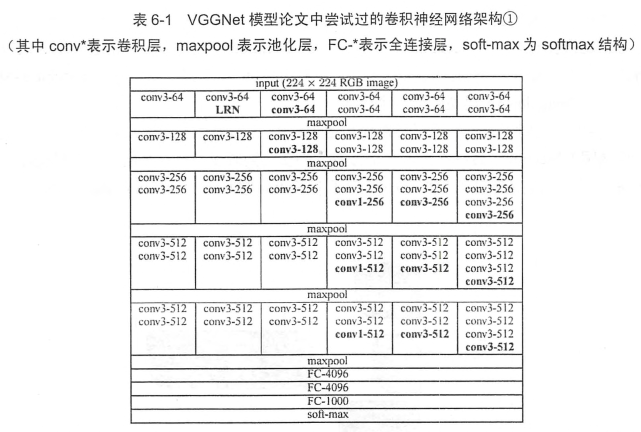
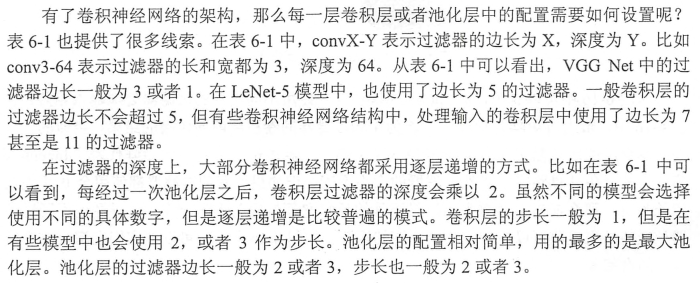

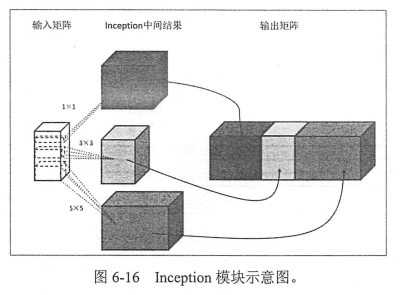
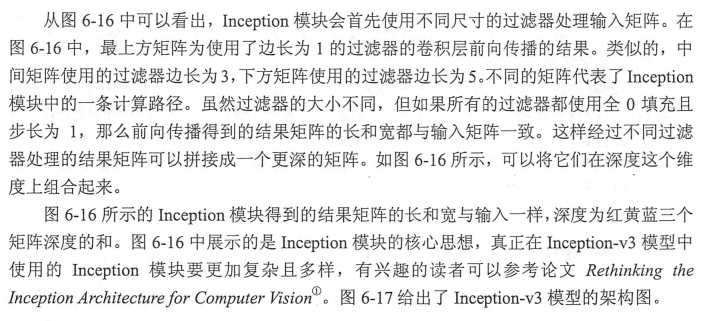
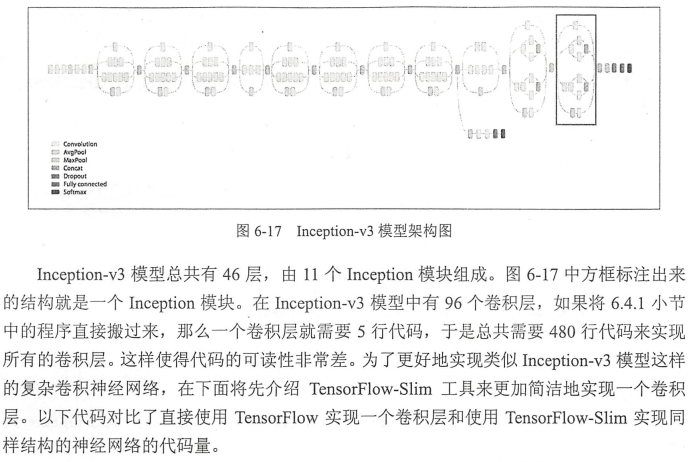
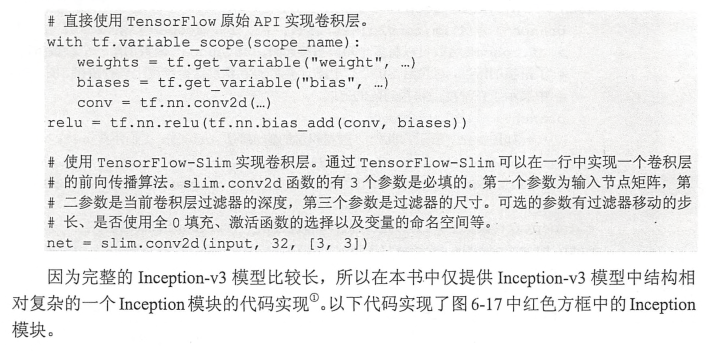
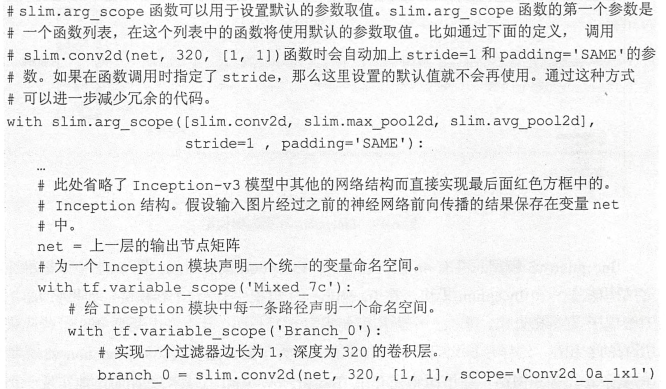
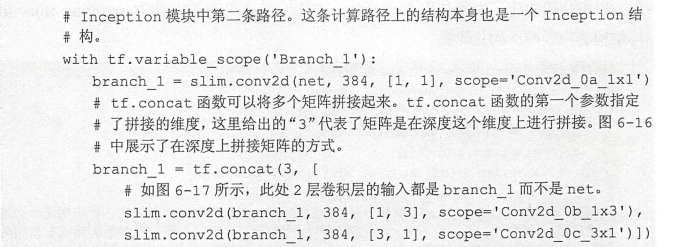
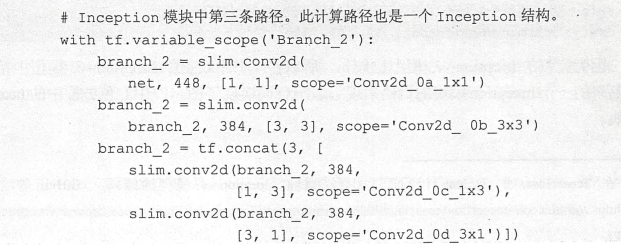
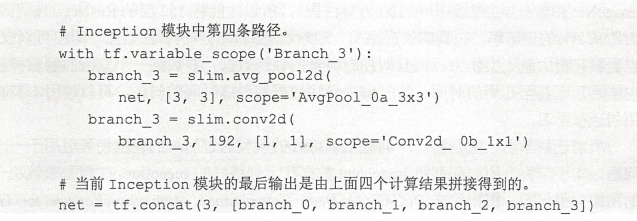
吴裕雄--天生自然python Google深度学习框架:经典卷积神经网络模型的更多相关文章
- 吴裕雄--天生自然python Google深度学习框架:Tensorflow实现迁移学习
import glob import os.path import numpy as np import tensorflow as tf from tensorflow.python.platfor ...
- 吴裕雄--天生自然python Google深度学习框架:图像识别与卷积神经网络
- 吴裕雄--天生自然python Google深度学习框架:MNIST数字识别问题
import tensorflow as tf from tensorflow.examples.tutorials.mnist import input_data INPUT_NODE = 784 ...
- 吴裕雄--天生自然python Google深度学习框架:深度学习与深层神经网络
- 吴裕雄--天生自然python Google深度学习框架:TensorFlow实现神经网络
http://playground.tensorflow.org/
- 吴裕雄--天生自然python Google深度学习框架:Tensorflow基础应用
import tensorflow as tf a = tf.constant([1.0, 2.0], name="a") b = tf.constant([2.0, 3.0], ...
- 吴裕雄--天生自然python Google深度学习框架:人工智能、深度学习与机器学习相互关系介绍
- 吴裕雄--天生自然神经网络与深度学习实战Python+Keras+TensorFlow:Bellman函数、贪心算法与增强性学习网络开发实践
!pip install gym import random import numpy as np import matplotlib.pyplot as plt from keras.layers ...
- 吴裕雄--天生自然神经网络与深度学习实战Python+Keras+TensorFlow:使用TensorFlow和Keras开发高级自然语言处理系统——LSTM网络原理以及使用LSTM实现人机问答系统
!mkdir '/content/gdrive/My Drive/conversation' ''' 将文本句子分解成单词,并构建词库 ''' path = '/content/gdrive/My D ...
随机推荐
- (转)null和NULL和nullptr和””区别
突然想到这个有趣的问题:C语言和C++对大小写是敏感的,也就是说null和NULL是区别对待的.NULL代表空地址,null只是一个符号.便来深究,看了很多资料,总结如下: 其实null和NULL都是 ...
- 线程与进程 queue模块
queue模块的基本用法 https://www.cnblogs.com/chengd/articles/7778506.html 模块实现了3种类型的队列,区别在于队列中条目检索的顺序不同.在FIF ...
- Python安装和虚拟环境创建以及外部库的安装
Python.虚拟环境.外部库的安装 一 安装Python 1 Windows 到官网下载对应的版本 下载地址 我选择的是Python3.6.8 下载完成后双击运行 !!!勾选Add Python 3 ...
- React yarn安装umi后 umi -v查询版本失败
采坑描述:yarn全局安装模块后但仍提示无法找到 解决: 1.先查看一下yarn的bin目录,输入yarn global bin 2.然后将该路径加入到path中,对于windows中直接将该目录加入 ...
- VS Code 配置vue开发环境
一.插件 网上搜索vscode插件的文章,动辄十几个,其实根本用不了那么多,很多插件的作用还有重叠,电脑性能还被白白浪费.这里精简为主,每一个插件都发挥它最大的作用,并尽量说明它们的作用 Vetur ...
- java里mongodb复合查询
Query query = new Query();Criteria criteria = Criteria.where("packetTitle").is(redPacketSt ...
- 1.1 js中函数定义解析(学习笔记)
1.1.1函数的分类 函数声明式 :使用function声明函数,并指定函数名. 函数表达式:使用function声明函数,但未指定函数名. 函数表达式2.匿名函数,匿名函数有很多作用,赋予一个变量则 ...
- Codeforces 1296E1 - String Coloring (easy version)
题目大意: 给定一段长度为n的字符串s 你需要给每个字符进行涂色,然后相邻的不同色的字符可以进行交换 需要保证涂色后能通过相邻交换把这个字符串按照字典序排序(a~z) 你只有两种颜色可以用来涂 问是否 ...
- MST(最小生成树)——Prim算法——HDU 1879-继续畅通工程
Prim算法很好理解,特别是学完了迪杰斯特拉算法之后,更加能理解Prim的算法思想 和迪杰斯特拉算法差不多,由于最后要形成连通图,故任意指定一个点,作为初始点,遍历所有点,以当前最小权值的点(和迪杰斯 ...
- ZOJ- 2562 反素数使用
借用了下东北师大ACM的反素数模版. 本来我是在刷线段树的,有一题碰到了反素数,所以学了一下..有反素数的存在,使得一个x ,使得x的约数个数,在1 到 x的所有数里面,是最大的. 这里面还涉及安叔那 ...
